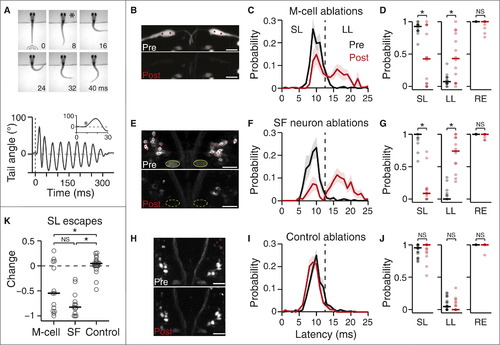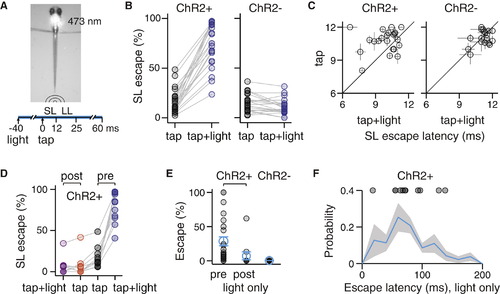- Title
-
A Convergent and Essential Interneuron Pathway for Mauthner-Cell-Mediated Escapes
- Authors
- Lacoste, A.M., Schoppik, D., Robson, D.N., Haesemeyer, M., Portugues, R., Li, J.M., Randlett, O., Wee, C.L., Engert, F., Schier, A.F.
- Source
- Full text @ Curr. Biol.
|
Spiral Fiber Neurons Respond to Aversive Stimuli (A) Left: 5-day-old zebrafish larvae. Top: Tg(-6.7FRhcrtR:gal4VP16); Tg(UAS:GCaMP5) labels spiral fiber neurons (arrowhead) among other neurons. The M-cell and other reticulospinal neurons are labeled with tetramethylrhodamine dextran by reticulospinal backfill. Spiral fiber neuron cell bodies are located in rhombomere 3 in two rostro-caudal (R← →C) clusters, approximately 25-40 µm rostral, 5-15 µm lateral, and 0-20 µm ventral of the axon cap (star). They all have axons descending contralaterally into the axon cap of the M-cell. Bottom: transient expression of membrane-targeted GFP (UAS:GAP43-GFP) in Tg(-6.7FRhcrtR:gal4VP16) labels two spiral fiber neurons on the left and one spiral fiber neuron on the right that project to the contralateral M-cell axon cap. (B) Left: three different stimuli were delivered to paralyzed zebrafish larvae?water puffs directed at the right ear, water puffs directed at the right side of the tail, and non-directional taps delivered onto the dish holding the fish. Top: projection of two-photon image stack showing M-cells and spiral fiber neuron axon terminals labeled with the calcium indicator Tg(UAS:GCaMP-HS) driven by Et(fos:Gal4-VP16)s1181t and Tg(-6.7FRhcrtR:gal4VP16), respectively. middle: Typical spontaneous activity in the spiral fiber neuron axon terminals. Scale bars represent 5 min horizontally and1 ?f/f vertically. Bottom: mean response amplitude in the right spiral fiber neuron axon terminals for different stimuli: ear puffs (n = 7, left), tail puffs (n = 5, center), and taps (n = 6, right). For each fish, the change in fluorescence (?f/f) from trials in which the axon cap was active was normalized to the maximum ?f/f across trials and then averaged. The black line is the mean across fish with the SEM shaded. Stimulus delivery is indicated by an arrowhead. The horizontal scale bar represents 2 s. (C) Top: single recording plane showing spiral fiber neuron somata in Tg(-6.7FRhcrtR:gal4VP16); Tg(UAS:GCaMP-HS). Bottom: mean ?f/f across trials in green and individual trials in gray for spiral fiber neuron somata from the top panel located on the left (dark green) and on the right (light green) responding to a water puff delivered to the right ear (arrow). Contralateral spiral fiber neurons respond to the stimulus, but ipsilateral spiral fiber neurons do not. Traces in which spiral fiber neurons on the left do not respond correspond to the same trials. Note that while caudal neurons seem to respond before rostral neurons, this is an artifact of the delay introduced by two-photon line scanning. Scale bars represent 2 s horizontally and 2 ?f/f vertically. (D) Boxplot showing the normalized response of spiral fiber neurons across fish. Response was defined as the area under the ?f/f curve over a 1.5 s response window. This was normalized for each cell to the maximum response observed in a given experiment, and then cells located on the contralateral and ipsilateral side with respect to the stimulus were averaged. Green lines are the medians across fish, box edges are the 25th and 75th percentiles, the whiskers extend to the most extreme data points not considered outliers, and crosses are outliers. The following stimuli were delivered: ear puffs (left; n = 10 fish, p = 2.5 × 10-4), tail puffs (center; n = 10, p = 0.02), and taps (right; n = 4, p = 0.89). p < 0.05; NS, not significant by Wilcoxon rank-sum test. (E) Model showing the M-cells receiving ipsilateral sensory input, which includes auditory/vestibular afferents onto the lateral dendrite. Our results suggest that spiral fiber neuron somata receive similar sensory information from the contralateral side. Pictures are oriented rostral up. Scale bars represent 20 µm. Arrows point to spiral fiber neuron somata, and a star indicates spiral fiber neuron terminals at the M-cell axon cap. Contra, contralateral; ipsi, ipsilateral; SL, short latency. See also Figure S1 and Movie S1. |
|
Loss of M-Cells or Spiral Fiber Neurons Largely Abolish Short-Latency Escapes (A) Top: representative escape behavior of a head-embedded larval zebrafish responding to a tap stimulus. Images were recorded every millisecond, and here every eighth image is shown. The first image was taken at the time the tap stimulus hit the dish holding the larvae. The image marked with a star corresponds to the beginning of the escape response (8 ms latency). Bottom: representative smoothed tail trace showing the angle of the last tail segment with respect to the vertical in response to a tap. The escape behavior consists of a sharp-angle C-bend, followed by a counter turn in the opposite direction and subsequent swimming lasting hundreds of milliseconds. The dotted line shows the stimulus. The inset shows the first 300 ms after stimulus onset and the star indicates the start of the C-bend. (B?J) Results of M-cell ablations (B?D; n = 14 fish), spiral fiber (SF) neuron ablations (E?G; n = 13), and control ablations (H?J; n = 23) on the escape behavior in response to taps. (B, E, and H) Stack projections showing before (top) and immediately after (B) or 24 hr after (E and H) two-photon laser-mediated bilateral ablations (bottom). Shown are Et(fos:Gal4-VP16)s1181t; Tg(UAS:GCaMP-HS) (B) and Tg(?6.7FRhcrtR:gal4VP16); Tg(UAS-E1b:Kaede) (E and H). Red dots mark the cells or location within the M-cell that were targeted for ablation. Green ovals in (E) mark the axon caps, which are no longer apparent 24 hr after ablations. High-fluorescence cell debris can be observed in the post images. (C, F, and I) Escape probability as a function of latency of all escapes performed, mean ± SEM, before (black) and after (red) ablations. The dotted line at 13 ms demarcates short-latency (f12 ms) and long-latency (13?25 ms) escapes. (D, G, and J) Probabilities of different types of responses as a function of all trials before (black) and after (red) ablations. Individual fish are displayed as semi-transparent dots, and horizontal bars are the medians. Left, SL escapes; middle, LL escapes; right, overall responses. M-cell: p = 0.013 pre versus post (SL), 0.016 (LL), and 0.125 (RE); spiral fiber neuron: p = 2.4 × 10?4, p = 2.4 × 10?4, and p = 0.25; control: p = 0.28, p = 0.20, and p = 1; Wilcoxon signed-rank test. (K) Change in SL escape probability as a function of all trials (post ? pre) based on the SL data plotted in (D), (G), and (J). Gray circles, individual fish; black line, median. M-cell versus spiral fiber neurons, p = 0.11; M-cell versus control, p = 0.011; spiral fiber neurons versus control, p = 1.6 × 10?6; Wilcoxon rank-sum test. p < 0.05; NS, not significant. Pictures are oriented rostral up. Scale bars represent 20 µm. SF, spiral fiber; LS, short latency; LL, long latency; RE, overall response. See also Figure S2. |
|
Spiral Fiber Neurons Are Necessary for Lateralized M-Cell-Mediated Escapes (A) Tail-free larvae are presented with a non-directional tap stimulus as in Figure 2. (B) Projection of two-photon image stack showing M-cells before (top) and 24 hr after (bottom) ablation of the M-cell on the left in Et(fos:Gal4-VP16)s1181t; Tg(UAS-E1b:Kaede). (C) Projection of two-photon image stack showing spiral fiber neurons before (top) and 24 hr after (bottom) ablation of spiral fiber neuron somata located on the right in Tg(?6.7FRhcrtR:gal4VP16); Tg(UAS-E1b:Kaede). The axon cap (green oval) contralateral to the targeted spiral fiber neurons is no longer apparent 24 hr after ablations. (D) Normalized change in short-latency (SL) escape probability as a function of all trials (post ? pre). Gray circles, individual fish; black line, median. Left: M-cell ablation (n = 11). Right: spiral fiber neuron ablations (n = 17). The probability change is not significantly different from 0 in either condition (p = 0.67 and p = 0.98, respectively; Wilcoxon signed-rank test). (E) Model showing that when M-cells or spiral fiber neurons are ablated unilaterally, escapes in response to taps become strongly biased toward one direction: ipsilateral to the ablated M-cell or contralateral to the ablated spiral fiber neurons. (F) Example tail traces for a fish before (top plots; black) and after (bottom plots; red) ablation of the left M-cell (left plots) and a fish before and after ablations of spiral fiber neuron somata on the right (right plots). The directionality of the initial tail bend is expressed as ipsilateral or contralateral with respect to the ablated soma(ta). Traces begin at the time of tap delivery. (G) Probability of contralateral SL escapes as a function of all SL escapes of either direction. Left: M-cell ablation. Right: spiral fiber neuron ablation. Escapes shift toward the ipsilateral side for M-cell ablation and to the contralateral side for spiral fiber neuron ablations. The laterality bias after M-cell or spiral fiber neuron ablation was not statistically distinguishable (p = 0.45, Wilcoxon rank-sum test). Scale bars: 20 µm. Pictures are oriented rostral up. SF, spiral fiber; LS, short latency; contra, contralateral; ipsi, ipsilateral. |
|
Activation of Spiral Fiber Neurons Enhances the Probability of M-Cell-Mediated Escapes (A) 473-nm blue light is shone on the hindbrain of Tg(?6.7FRhcrtR:gal4VP16); Tg(14xUAS-E1b:hChR2(H134R)-EYFP) larvae using a focused laser beam for a total of 100 ms. 20?60 ms after the onset of the light, a low-intensity tap is delivered, and tail movements are scored for short-latency (SL) or long-latency (LL) escapes. (B) Percentage of SL escapes for individual fish in response to taps alone (black circles) and taps paired with blue light (blue circles). Left: ChR2+ fish (n = 22; 17% ± 4.9% tap, 73.4% ± 4.7% tap + light, mean ± SEM, corresponding to a 4.4-fold enhancement of SL escapes with blue light; p = 4.0 × 10?5). Right: ChR2? controls (n = 22; 15% ± 1.9% tap, 11% ± 1.7% tap + light, corresponding to a 1.4-fold decrease of SL escapes with blue light; p = 0.01, Wilcoxon signed-rank test). (C) SL escape latency in milliseconds in response to taps (y axis) or taps paired with blue light (x axis) for individual fish tested (black circles). Left: ChR2+ fish (n = 22; 11 ± 0.22 ms tap, 9.9 ± 0.27 ms tap + light, mean ± SEM; p = 0.01). Right: ChR2? fish (n = 22; 11 ± 0.14 ms tap, 11 ± 0.13 ms ms tap + light; p = 0.72, Wilcoxon signed-rank test). (D) Percentage of SL escapes in response to taps or taps paired with light before (pre) or after (post) bilateral spiral fiber neuron ablations. (n = 11 ChR+ larvae; pre: 17% ± 3.7% tap, 78 ± 5.4% tap + light, mean ± SEM, corresponding to a 4.7-fold enhancement; p = 9.8 × 10?4; post: 6.3% ± 3.5% tap, 5.6 ± 2.9% tap + light, p = 0.58; Wilcoxon signed-rank test). Data in the pre condition are a subset of the data in (B). (E) Percentage of escapes for individual fish (black circles, mean ± SEM in blue) in response to blue light alone (in the absence of taps). ChR2+ fish before (pre; n = 22) and after (post; n = 11) spiral fiber neuron ablations. ChR2? fish, n = 22. (F) Distribution of escape latencies in ChR2+ fish after the onset of a 100-ms blue light pulse (blue line ± shaded SEM; n = 185 escapes, n = 11 fish). Circles represent the mean of escape latencies for larvae displaying >10% probability of escapes (see ?pre? in E; n = 11). Note: to ensure that escapes to blue light alone could be disambiguated with escapes in response to taps paired with light, larvae that responded to blue light alone with mean escapes latencies <70 ms were tested with a 20-ms delay between taps and blue light; otherwise, 40- or 60-ms delays were used (see A). See also the Supplemental Experimental Procedures. ChR2, channelrhodopsin 2; LS, short latency; LL, long latency. See also Figure S3. |




